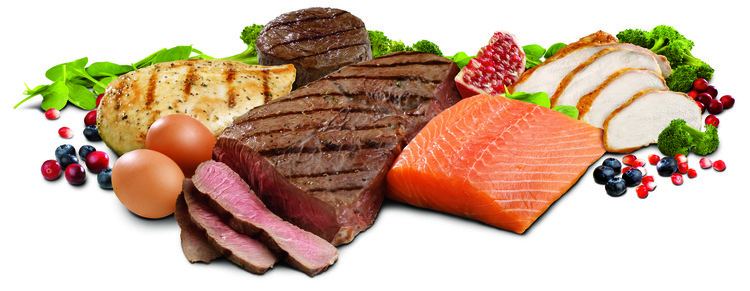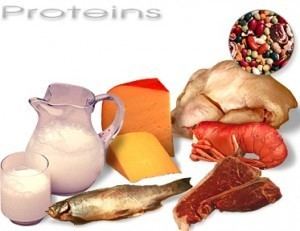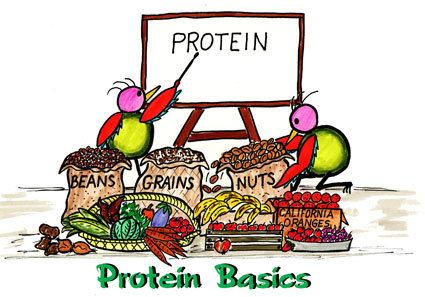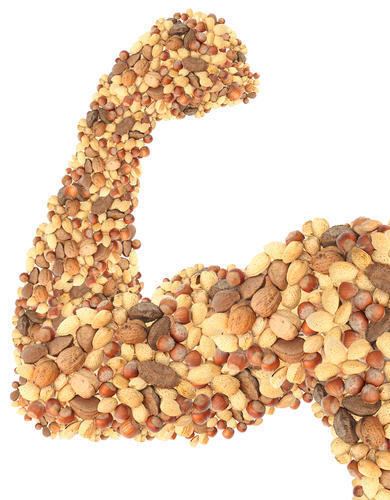 | ||
Proteins are essential nutrients for the human body. They are one of the building blocks of body tissue, and can also serve as a fuel source. As a fuel, proteins provide as much energy density as carbohydrates: 4 kcal (17 kJ) per gram; in contrast, lipids provide 9 kcal (37 kJ) per gram. The most important aspect and defining characteristic of protein from a nutritional standpoint is its amino acid composition.
Contents
- Protein functions in body
- Protein function in exercise
- Digestion
- Newborn
- Dietary requirements
- Active people
- Aerobic exercise protein needs
- Anaerobic exercise protein needs
- Phenylketonuria
- Maple syrup urine disease
- Excess consumption
- Testing in foods
- Protein deficiency
- References

Proteins are polymer chains made of amino acids linked together by peptide bonds. During human digestion, proteins are broken down in the stomach to smaller polypeptide chains via hydrochloric acid and protease actions. This is crucial for the synthesis of the essential amino acids that cannot be biosynthesized by the body.

There are nine essential amino acids which humans must obtain from their diet in order to prevent protein-energy malnutrition and resulting death. They are phenylalanine, valine, threonine, tryptophan, methionine, leucine, isoleucine, lysine, and histidine. There are five dispensable amino acids which humans are able to synthesize in the body. These five are alanine, aspartic acid, asparagine, glutamic acid and serine. There are six conditionally essential amino acids whose synthesis can be limited under special pathophysiological conditions, such as prematurity in the infant or individuals in severe catabolic distress. These six are arginine, cysteine, glycine, glutamine, proline and tyrosine.

Humans need the essential amino acids in certain ratios. Some protein sources contain amino acids in a more or less 'complete' sense. This has given rise to various ranking systems for protein sources, as described in the article.

Dietary sources of protein include both animals and plants: meats, dairy products, fish and eggs as well as grains, legumes and nuts. Vegetarians and vegans can get enough essential amino acids by eating a variety of plant proteins. It is commonly believed that athletes should consume a higher-than-normal protein intake to maintain optimal physical performance.

Protein functions in body

Protein is a nutrient needed by the human body for growth and maintenance. Aside from water, proteins are the most abundant kind of molecules in the body. Protein can be found in all cells of the body and is the major structural component of all cells in the body, especially muscle. This also includes body organs, hair and skin. Proteins are also used in membranes, such as glycoproteins. When broken down into amino acids, they are used as precursors to nucleic acid, co-enzymes, hormones, immune response, cellular repair, and other molecules essential for life. Additionally, protein is needed to form blood cells.
Protein function in exercise

Proteins are believed to increase performance in terms of athletics. Amino acids, the building blocks of proteins, are used for building muscle tissue and repairing damaged tissues. Protein is only used as anaerobic fuel when carbohydrates are low, or as aerobic fuel when lipid resources are also low.
Digestion
Most proteins are decomposed to single amino acids by digestion in the gastro-intestinal tract.
Digestion typically begins in the stomach when pepsinogen is converted to pepsin by the action of hydrochloric acid, and continued by trypsin and chymotrypsin in the small intestine. Before the absorption in the small intestine, most proteins are already reduced to single amino acid or peptides of several amino acids. Most peptides longer than four amino acids are not absorbed. Absorption into the intestinal absorptive cells is not the end. There, most of the peptides are broken into single amino acids.
Absorption of the amino acids and their derivatives into which dietary protein is degraded is done by the gastrointestinal tract. The absorption rates of individual amino acids are highly dependent on the protein source; for example, the digestibilities of many amino acids in humans, the difference between soy and milk proteins and between individual milk proteins, beta-lactoglobulin and casein. For milk proteins, about 50% of the ingested protein is absorbed between the stomach and the jejunum and 90% is absorbed by the time the digested food reaches the ileum. Biological value (BV) is a measure of the proportion of absorbed protein from a food which becomes incorporated into the proteins of the organism's body.
Newborn
Newborns of mammals are exceptional in protein digestion and assimilation in that they can absorb intact proteins at the small intestine. This enables passive immunity from milk.
Dietary requirements
Considerable debate has taken place regarding issues surrounding protein intake requirements. The amount of protein required in a person's diet is determined in large part by overall energy intake, the body's need for nitrogen and essential amino acids, body weight and composition, rate of growth in the individual, physical activity level, individual's energy and carbohydrate intake, as well as the presence of illness or injury. Physical activity and exertion as well as enhanced muscular mass increase the need for protein. Requirements are also greater during childhood for growth and development, during pregnancy or when breast-feeding in order to nourish a baby, or when the body needs to recover from malnutrition or trauma or after an operation.
If not enough energy is taken in through diet, as in the process of starvation, the body will use protein from the muscle mass to meet its energy needs, leading to muscle wasting over time. If the individual does not consume adequate protein in nutrition, then muscle will also waste as more vital cellular processes (e.g. respiration enzymes, blood cells) recycle muscle protein for their own requirements.
According to US & Canadian Dietary Reference Intake guidelines, women aged 19–70 need to consume 46 grams of protein per day, while men aged 19–70 need to consume 56 grams of protein per day to minimize risk of deficiency. These Recommended Dietary Allowances (RDAs) were calculated based on 0.8 grams protein per kilogram body weight and average body weights of 57 kg (126 pounds) and 70 kg (154 pounds) respectively. However, this recommendation is based on structural requirements, but disregards use of protein for energy metabolism. This requirement is for a normal sedentary person. In the United States, average protein consumption is higher than the RDA. According to the most recently published results of the National Health and Nutrition Examination Survey (NHANES 2013-2014) average protein consumption for women ages 20 and older was 69.8 grams and for men 98.3 grams/day.
Active people
Several studies have concluded that active people and athletes may require elevated protein intake (compared to 0.8 g/kg) due to increase in muscle mass and sweat losses, as well as need for body repair and energy source. Suggested amounts vary between 1.6 g/kg and 1.8 g/kg, while a proposed maximum daily protein intake would be approximately 25% of energy requirements i.e. approximately 2 to 2.5 g/kg. However, many questions still remain to be resolved.
In addition, some have suggested that athletes using restricted-calorie diets for weight loss should further increase their protein consumption, possibly to 1.8–2.0 g/kg, in order to avoid loss of lean muscle mass.
Aerobic exercise protein needs
Endurance athletes differ from strength-building athletes in that endurance athletes do not build as much muscle mass from training as strength-building athletes do. Research suggests that individuals performing endurance activity require more protein intake than sedentary individuals so that muscles broken down during endurance workouts can be repaired. Although the protein requirement for athletes still remains controversial (for instance see Lamont, Nutrition Research Reviews, pages 142 - 149, 2012), research does show that endurance athletes can benefit from increasing protein intake because the type of exercise endurance athletes participate in still alters the protein metabolism pathway. The overall protein requirement increases because of amino acid oxidation in endurance-trained athletes. Endurance athletes who exercise over a long period (2–5 hours per training session) use protein as a source of 5–10% of their total energy expended. Therefore, a slight increase in protein intake may be beneficial to endurance athletes by replacing the protein lost in energy expenditure and protein lost in repairing muscles. Some scientists suggest that endurance athletes may increase daily protein intake to a maximum of 1.2–1.4 g per kg body weight.
Anaerobic exercise protein needs
Research also indicates that individuals performing strength-training activity require more protein than sedentary individuals. Strength-training athletes may increase their daily protein intake to a maximum of 1.4–1.8 g per kg body weight to enhance muscle protein synthesis, or to make up for the loss of amino acid oxidation during exercise. Many athletes maintain a high-protein diet as part of their training. In fact, some athletes who specialize in anaerobic sports (e.g., weightlifting) believe a very high level of protein intake is necessary, and so consume high protein meals and also protein supplements.
Phenylketonuria
Individuals with phenylketonuria (PKU) must keep their intake of phenylalanine extremely low to prevent a mental disability and other metabolic complications.
Maple syrup urine disease
Maple syrup urine disease is associated with genetic anomalies in the metabolism of branched-chain amino acids (BCAAs). They have high blood levels of BCAAs and must severely restrict their intake of BCAAs in order to prevent mental retardation and death.
Excess consumption
Research indicates that a high protein diet is carcinogenic, and that the cancer risk is somewhat decreased if it's non-animal protein. When a high dietary protein intake is consumed, there is an increase in urea excretion, which suggests that amino acid oxidation is increased.High levels of protein intake increase the activity of branched-chain ketoacid dehydrogenase. As a result, oxidation is facilitated, and the amino group of the amino acid is excreted to the liver. This process suggests that excess protein consumption results in protein oxidation and that the protein is excreted. The body is unable to store excess protein. Protein is digested into amino acids, which enter the bloodstream. Excess amino acids are converted to other usable molecules by the liver in a process called deamination. Deamination converts nitrogen from the amino acid into ammonia, which is converted by the liver into urea in the urea cycle. Excretion of urea is performed by the kidneys. These organs can normally cope with any extra workload, but, if kidney disease occurs, a decrease in protein will often be prescribed. When there is excess protein intake, amino acids can be converted to glucose or ketones, in addition to being oxidized for fuel. When food protein intake is periodically high or low, the body tries to keep protein levels at an equilibrium by using the "labile protein reserve", which serves as a short-term protein store to be used for emergencies or daily variations in protein intake. However, that reserve is not utilized as longer-term storage for future needs.
Many researchers have also found that excessive intake of protein increases calcium excretion in urine. It has been thought that this occurs to maintain the pH imbalance from the oxidation of sulfur amino acids. Also, it is inconclusive whether bone resorption contributes to bone loss and osteoporosis. However, it is also found that a regular intake of calcium would be able to stabilize this loss.
Another issue arising from over-consumption of protein is a higher risk of kidney stone formation from calcium in the renal circulatory system. It has been found that high animal protein intake in healthy individuals increases the probability of forming kidney stones by 250 percent.
An epidemiological study from 2006 has found no relationship between total protein intake and blood pressure; it did, however, find an inverse relationship between vegetable protein intake and blood pressure.
Saying they eat too much protein, the 2015–2020 Dietary Guidelines for Americans asked men and teenage boys to increase their consumption of vegetables or other underconsumed foods.
Testing in foods
The classic assays for protein concentration in food are the Kjeldahl method and the Dumas method. These tests determine the total nitrogen in a sample. The only major component of most food which contains nitrogen is protein (fat, carbohydrate and dietary fiber do not contain nitrogen). If the amount of nitrogen is multiplied by a factor depending on the kinds of protein expected in the food the total protein can be determined. This value is known as the "crude protein" content. On food labels the protein is given by the nitrogen multiplied by 6.25, because the average nitrogen content of proteins is about 16%. The Kjeldahl test is typically used because it is the method the AOAC International has adopted and is therefore used by many food standards agencies around the world, though the Dumas method is also approved by some standards organizations.
Accidental contamination and intentional adulteration of protein meals with non-protein nitrogen sources that inflate crude protein content measurements have been known to occur in the food industry for decades. To ensure food quality, purchasers of protein meals routinely conduct quality control tests designed to detect the most common non-protein nitrogen contaminants, such as urea and ammonium nitrate.
In at least one segment of the food industry, the dairy industry, some countries (at least the U.S., Australia, France and Hungary), have adopted "true protein" measurement, as opposed to crude protein measurement, as the standard for payment and testing: "True protein is a measure of only the proteins in milk, whereas crude protein is a measure of all sources of nitrogen and includes nonprotein nitrogen, such as urea, which has no food value to humans. ... Current milk-testing equipment measures peptide bonds, a direct measure of true protein." Measuring peptide bonds in grains has also been put into practice in several countries including Canada, the UK, Australia, Russia and Argentina where near-infrared reflectance (NIR) technology, a type of infrared spectroscopy is used. The Food and Agriculture Organization of the United Nations (FAO) recommends that only amino acid analysis be used to determine protein in, inter alia, foods used as the sole source of nourishment, such as infant formula, but also provides: "When data on amino acids analyses are not available, determination of protein based on total N content by Kjeldahl (AOAC, 2000) or similar method ... is considered acceptable."
The limitations of the Kjeldahl method were at the heart of the Chinese protein export contamination in 2007 and the 2008 China milk scandal in which the industrial chemical melamine was added to the milk or glutens to increase the measured "protein".
Protein deficiency
Protein deficiency and malnutrition can lead to variety of ailments including mental retardation and kwashiorkor. Symptoms of kwashiorkor include apathy, diarrhea, inactivity, failure to grow, flaky skin, fatty liver, and edema of the belly and legs. This edema is explained by the action of lipoxygenase on arachidonic acid to form leukotrienes and the normal functioning of proteins in fluid balance and lipoprotein transport.
PEM is fairly common worldwide in both children and adults and accounts for 6 million deaths annually. In the industrialized world, PEM is predominantly seen in hospitals, is associated with disease, or is often found in the elderly.
